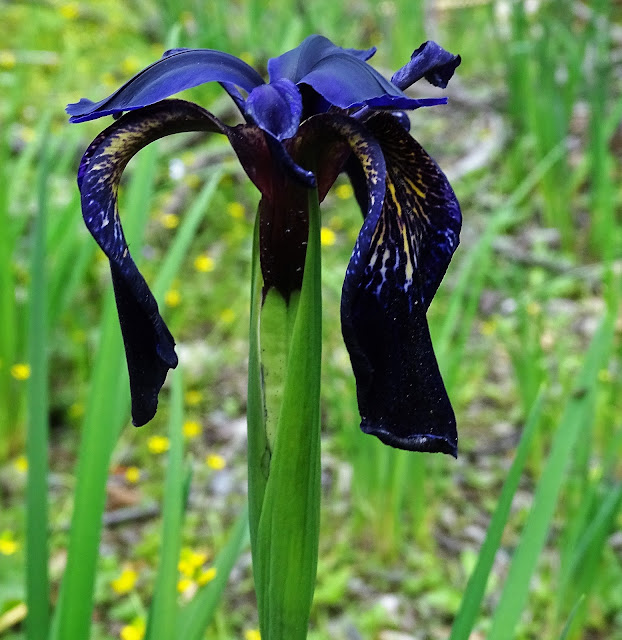 |
| Iris dolichosiphon |
At first I took it for I. decora, which it superficially resembles: in fact, I. dolichosiphon is in the Pseudo-Regelia section of the genus--which means it's much more closely related to bearded iris and that it is in fact an Aril iris. I had grown its cousin from Qinghai, Iris goniocarpa in my Eudora garden where it had even produced seed and prospered for a while--so I should have known better! If I'd try digging these (I didn't of course), I'd have known it wasn't Iris decora, which has tiny dahlia like tubers.
Here Matt Mattus--past president of the North American Rock Garden Society--is busy taking pictures (his are far better than mine).. Fortunately, I like the fellow and forgive me for upstaging me--if you don't know his blog, do click there: his pictures and commentary are superb. (Notice how many there are in the picture!
Nearby you can see a clump growing in the matrix of grasses and an enormous variety of herbs--this is a small village between Tiger Leaping Gorge and Shangrila (Zhongdian) on the high plateau of northern Yunnan. We were to find this iris several other spots in the region.
Here is the same species growing on a wall at a Monastery complex just outside Zhongdian ("Shangrila"). I always thought iris would make good green roof plants.
And here is a closeup of the walltop specimen. The tell-tail beard reveals its true affinity!
 |
| Iris dolichosiphon on the road to Tianqi lake |

Iris chrysographes
We spent three days at a "rustic hut" (which wasn't so very rustic--very comfortable accommodations) in the Hong Shan area--the highlight there being the abundance of Iris chrysographes. The forty chromosome Siberians of Western China have an elegance and form quite distinct from their much more easily grown Eurasian cousins we know and love (I. sibirica and I. sanguinea). They aren't as amenable or permanent in culture--althoujgh I'll end with a picture or two of some wonderful species we have grown well for a while...

Here is a classic habitat--not too far from water.
I was amazed at how variable the flower form was from one specimen to the next.
 |
| Iris bulleyana |
 |
| Iris bulleyana |
These also have an excellent carriage and sbstance
Few spectacles on earth delight me more than a big field of wild iris in bloom like this. I grew up enchanted with fields of Iris missouriensis forming in azure pools of color along the Colorado in Middle Park. This deeper blue-purple was just as enchanting for me.
 |
| Iris bulleyana albino |
 |
| Iris ruthenica |
Wild iris are one of the very best reasons to live on this planet and cherish it.














Blue irises of any sort are dear to my heart -- and Yunnan (where my father was a medic with the Friends' Ambulance Unit for 3 years during WW II) is a place Carl and I enjoyed visiting so much back in the 80's. This was a wonderful treat!Lucie
ReplyDeleteThank you for posting. I found it very interesting. Janet Miller, Group for Beardless Irises in UK. Any seeds would be most welcome.
ReplyDelete